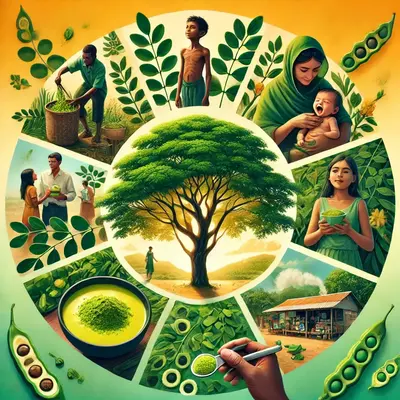Malnutrition and poverty are inextricably linked, creating a devastating cycle that affects millions worldwide, particularly in developing countries. Addressing these global challenges requires innovative and sustainable solutions. Moringa oleifera, often called the "miracle tree," offers a promising avenue for combating malnutrition and empowering impoverished communities. This article explores the potent nutritional benefits of Moringa and its potential to break the cycle of poverty and hunger.
Understanding Malnutrition
Malnutrition encompasses a range of nutrient deficiencies and imbalances that hinder growth, development, and overall health. It can manifest as undernutrition (lack of essential nutrients) or overnutrition (excessive intake of unhealthy foods), leading to various health problems. Micronutrient deficiencies, like Vitamin A deficiency, iron deficiency, and zinc deficiency, are particularly prevalent in vulnerable populations, causing severe health consequences, especially in children. Moringa is packed with these nutrients.
Moringa: A Nutritional Treasure Trove
Moringa is renowned for its exceptional nutritional profile. Its leaves, seeds, and pods are rich in essential vitamins, minerals, and antioxidants. Some key nutrients found in moringa include:
- Vitamin A: Crucial for vision, immune function, and cell growth.
- Vitamin C: A powerful antioxidant that boosts the immune system.
- Iron: Essential for red blood cell production and oxygen transport.
- Calcium: Important for bone health, muscle function, and nerve transmission.
- Protein: Essential for building and repairing tissues.
- Potassium: Important for maintaining healthy blood pressure and fluid balance.
Compared to common foods, moringa often boasts significantly higher levels of these essential nutrients.
Moringa's Role in Food Security and Sustainable Agriculture
Beyond its nutritional value, Moringa plays a crucial role in promoting food security and sustainable agriculture. Its drought resistance allows it to thrive in arid and semi-arid regions where other crops struggle. The tree is easy to grow and requires minimal maintenance, making it an ideal crop for smallholder farmers.
Sustainable agriculture practices involving moringa can improve soil fertility, reduce reliance on chemical fertilizers, and enhance biodiversity. By integrating moringa into farming systems, communities can improve their food security and build resilience to climate change. Check out our article on the affordable uses of Moringa, including its use in fertilizer.
Moringa for Vulnerable Populations
Moringa holds particular promise for addressing malnutrition in vulnerable populations, including children, pregnant women, and breastfeeding mothers.
- Children: Moringa can be easily incorporated into children's diets in the form of powder, added to porridge, or mixed with other foods. Its high nutrient content helps support healthy growth and development.
- Pregnant and Breastfeeding Women: Pregnant and breastfeeding women have increased nutritional needs. Moringa can help meet these needs, providing essential vitamins and minerals for both mother and child.
Moringa's Potential to Combat Poverty
The cultivation, processing, and sale of moringa products can create income-generating opportunities for impoverished communities. Smallholder farmers can sell moringa leaves, seeds, and oil in local markets, increasing their household income and improving their livelihoods.
Furthermore, moringa-based businesses can create employment opportunities for women and youth, empowering them to escape poverty and build a better future.
Conclusion
Moringa oleifera is more than just a tree; it's a symbol of hope for combating malnutrition and poverty. With its exceptional nutritional value, drought resistance, and income-generating potential, moringa offers a sustainable and empowering solution for communities facing these challenges. By harnessing the power of moringa, we can contribute to a healthier, more equitable, and sustainable future for all.
Learn more about our work in combating malnutrition with moringa. About Us. Find More Useful resources in our Resources Section. Contact us to learn how you can get involved.
Related Articles
Disclaimer
This information is for educational purposes only and not medical advice. Consult a healthcare professional before dietary changes.
